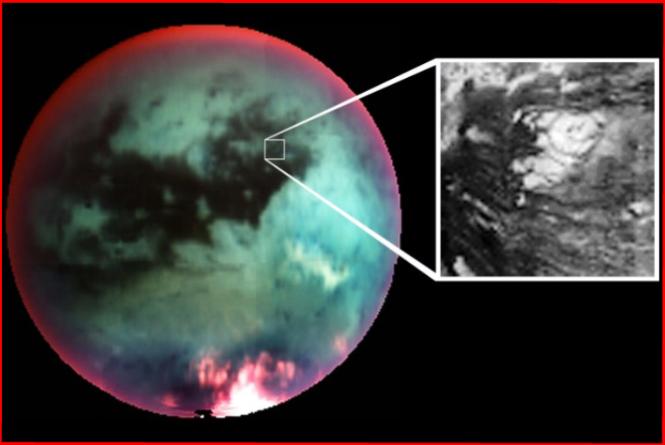
home •
about •
essential guide •
picture of the day •
thunderblogs •
news •
multimedia •
predictions •
products •
get involved •
contact

Credit: VIMS Team, U. Arizona, ESA, NASA
pic of the day
archive
subject index
abstract
archive
Links:
Society for
Interdisciplinary
Studies
Jun 28, 2005
An Electrical Blister on Titan
Nothing much is supposed to have happened on Saturn and its moons for billions of years. But the Cassini probe is discovering evidence of a recent event, and a thunderbolt scar indicates what that event might have been.
The conventional theory for the origin of the planets and their moons assumes that little has happened since they condensed from a cloud billions of years ago. The inundation of data from space probes that indicates relatively recent activity has been a surprise. When the Cassini probe discovered that Saturn’s largest moon, Titan, was rapidly losing its atmospheric methane, conventional theorists had to come up with some mechanism that would have replenished the loss over billions of years.
One of the first proposals was that Titan had oceans of methane that evaporated fast enough to compensate for the atmospheric loss. But the Huygens probe found no evidence for such oceans. Then the discovery of a “domed feature” suggested a solution: Perhaps it was a “cryovolcano”, an eruption of a nearly frozen mixture of ammonia, water, methane and other hydrocarbons. Such eruptions from a hidden interior source of unknown extent would provide methane in amounts that could be adjusted to match the measured loss.
This kind of case-by-case salvaging of a preconceived belief marks a theory in crisis. Theorists “explain away” anomalous observations that are contrary to entailments of the theory rather than confront the necessity for a new theory.
The Electric Universe proposes a more general and more straightforward explanation: Titan is losing methane because Titan is young and has not yet reached an equilibrium condition.
In an electric solar system, planets may not form all at once. Fluctuations in the galactic currents powering the system can cause episodes of fissioning, in which the star expels condensed and charged clumps of matter from its interior. These clumps become gas-giant planets, which interact electrically as they orbit within the star’s plasma sheath.
At the next lower scale of activity, the gas giants may also experience episodes of electrical “overstress”, at which times they may expel smaller and more-condensed clumps—the rocky planets and moons. Over a relatively short time, the electrical interactions tend to transfer energy among the planets and moons so that their interactions are minimized. This results in a distribution of orbits that, to gravity-only observers, appears to have been stable for eons.
In this view, many of the anomalous observations of the planets are understandable as direct consequences of the electrical theory, without the theory having to be adjusted case by case. Furthermore, the anomalous observations correlate with the most ancient human reports about conditions in the heavens, reports that heretofore have simply been dismissed as nonsense. (This conventional assertion implies that the ancients, living at a near-subsistence level, nevertheless diverted large amounts of resources and labor into commemorations of nonsense.) This ancient body of records indicates that at the dawn of history Saturn underwent such a fissioning event. It’s possible that Titan was expelled in that event and that Saturn’s rings are also a remnant of it.
Because Titan—and any other bodies expelled with it—would have been highly positively charged with respect to their new environment outside Saturn, they would have experienced intense electrical discharging immediately after expulsion. Interplanetary and inter-satellite lightning arcs—thunderbolts—would have flown between new and old bodies. Arcs touching the surface would have raised anode blisters, called fulgamites. These are domed features, or more accurately, pancake-like features. They have steep scarps around the edge and a steep-edged, flat-bottomed crater (or several overlapping craters) in the center. Typical examples are abundant on Venus as well as on Mars and the Moon.
Closer inspection of this “cryovolcano” on Titan will likely find that it has more in common with a fulgamite than with an oozing cold hydrocarbon soup.
EXECUTIVE EDITORS:
David Talbott, Wallace Thornhill
MANAGING EDITOR: Amy Acheson
CONTRIBUTING EDITORS: Mel Acheson, Michael Armstrong, Dwardu Cardona,
Ev Cochrane, C.J. Ransom, Don Scott, Rens van der Sluijs, Ian Tresman
WEBMASTER: Michael Armstrong
Copyright 2005: thunderbolts.info